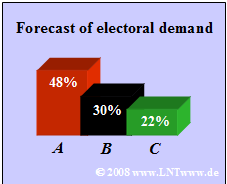Exercise 2.1: Election Demand
From LNTwww
In an election, the three candidates $A$, $B$ and $C$ are running for mayor.
- The candidate who receives more than $50\%$ of the votes cast is elected.
- If none of the three candidates succeeds in the first ballot, a run-off election shall be held between the two candidates with the most votes.
Immediately after the closing of the polling stations, the result of an election demand shall be presented:
- Candidate $A$: $48\%$, Candidate $B$: $30\%$, Candidate $C$: $22\%$.
This demand is based on a survey of only $N = 2000$ of the total $N' = 800 \hspace{0.05cm}000$ voters.
In answering the following questions, assume the following:
- The actual (percentage) votes obtained in the election by candidates $A$, $B$ and $C$ can be taken as the probabilities $p_{\rm A}$, $p_{\rm B}$ and $p_{\rm C}$ although these are also themselves determined as relative frequencies $($related to $N')$ .
- The $2000$ selected voters ideally represent the entire electorate in a statistical sense and answered truthfully when asked to vote.
- According to Bernoulli's Law of Large Numbers the results of this demand are to be understood as relative frequencies:
- $$h_{\rm A} = 0.48,\hspace{0.8cm}h_{\rm B} = 0.30,\hspace{0.9cm} h_{\rm C} = 0.22.$$
Hints:
- The exercise belongs to the chapter From Random Experiment to Random Variable.
- The topic of this chapter is illustrated with examples in the (German language) learning video Bernoullisches Gesetz der großen Zahlen $\Rightarrow$ Bernoulli's Law of Large Numbers.
Questions
Musterlösung
(1) Man sollte dieser Nachfrage zumindest glauben, dass $\underline{\text{Kandidat} \ A}$ wahrscheinlich gewinnt.
(2) Die Wahrscheinlichkeit, dass die Nachfrage $(h_{\rm A})$ vom endgültigen Ergebnis $(p_{\rm A})$ betragsmäßig um mehr als $2\%$ abweicht, ist nach dem Bernouillischen Gesetz der großen Zahlen mit $N = 2000$:
- $${\rm Pr}(|h_{\rm A} - p_{\rm A}| \geq 0.02) \leq \frac{1}{4 \cdot 2000\cdot 0.02^2} = 0.3125.$$
- Diese Wahrscheinlichkeit beinhaltet die beiden gleichwahrscheinlichen Fälle, dass $p_{\rm A} \le 46\%$ und $p_{\rm A} \ge 50\%$ ist.
- Nur im letzten Fall gibt es keine Stichwahl:
- $${\rm Pr(keine\hspace{0.1cm}Stichwahl)} \le 0.156 \hspace{0.15cm}\underline{=15.6 \%}.$$
(3) Mit $\varepsilon = 4\%$ $($ergibt sich aus $0.26 -0.22)$ liefert das Gesetz der großen Zahlen:
- $${\rm Pr}\left(|h_{\rm C}-p_{\rm C}|\ge 0.04\right)\le\rm\frac{1}{4\cdot 2000\cdot 0.04^2}=0.078.$$
Daraus folgt:
- Die Wahrscheinlichkeit, dass Kandidat $C$ mindestens $26\%$ der Stimmen erhält, ist nicht größer als $3.9\%$.
- Da $p_{\rm A} = 0.48$ fest vorausgesetzt wurde, gilt in diesem Fall gleichzeitig $p_{\rm B} \le 0.26$.
- Da es sich hier um kontinuierliche Zufallsgrößen handelt, sind $(p_{\rm C} \ge 0.26, \; p_{\rm B} \le 0.26)$ und $(p_{\rm C} > 0.26, \; p_{\rm B}< 0.26)$ gleich.
- Damit ist die Wahrscheinlichkeit, dass $C$ die Stichwahl erreicht, ebenfalls auf $3.9\%$ beschränkt:
- $${\rm Pr(}C\rm \hspace{0.1cm}erreicht\hspace{0.1cm}Stichwahl)\le 0.039 \hspace{0.15cm}\underline{= 3.9 \%}.$$
